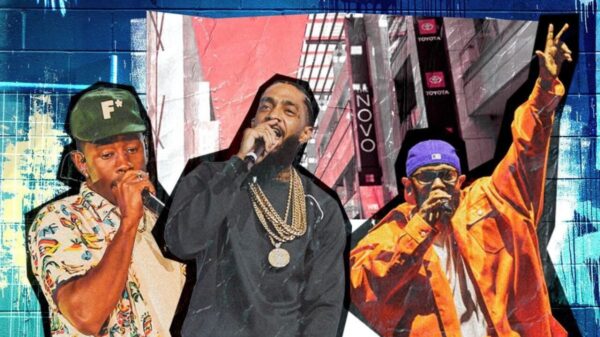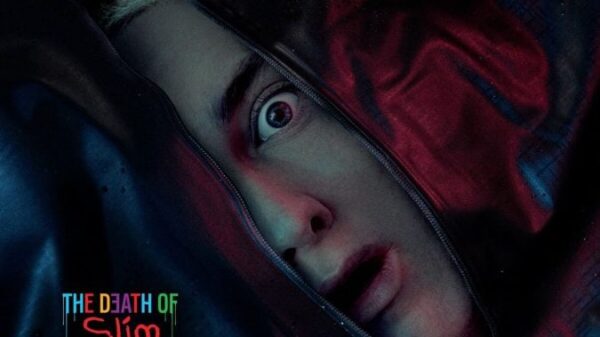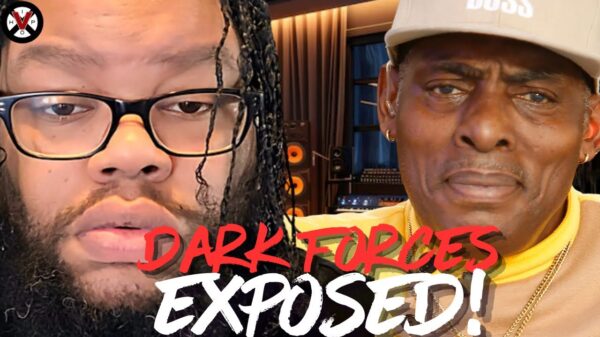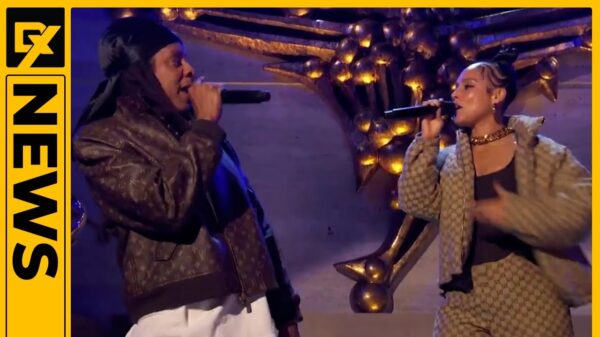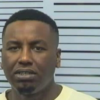This article has been handpicked from the Okayplayer editorial archives and included in our Hip Hop 50 collection as a noteworthy inclusion to the genre’s rich and diverse narrative. The article has been edited for context to ensure its accuracy and relevance.
Where would hip-hop be without the female hook? Without Mary J. Blige belting out “Taking out this time…To give you a piece of my mind” on JAY-Z’s “Can’t Knock the Hustle?” Or Val Young’s ode to the highs and lows of California life alongside Tupac Shakur on “To Live and Die in L.A”? Sometimes we were even spoiled for choice, as was the case with Biggie’s “One More Chance” that had versions of Faith Evans and Total on the hook.
In the case of these well-known female singers, some of their hip-hop features complemented an already vibrant solo discography. But when it comes to ‘90s rap, there are other lesser-known and celebrated female singers who’ve been part of some of hip-hop’s most historic tracks. Out west, Brooklyn-born Nanci Fletcher collaborated with the likes of Dr. Dre, 2Pac, and Snoop, whose hair she regularly braided during the most vibrant era of west coast hip-hop. In the midwest, Shatasha Williams, the forgotten singer on Bone Thugs-n-Harmony’s “Thuggish Ruggish Bone,” continues to generate buzz on social media 30 years later, so much so that a TikTok challenge centered around her hook went viral throughout 2020 and 2021 (with Williams even participating herself).
We spoke to Fletcher, Williams, and other female singers to get their testimony about the hip-hop classics they helped make. We heard from these women as they told their story about how they found their way to hip-hop, the rappers they worked alongside, and the legendary ‘90s tracks they helped mint. Part of this tale is about how years later, some of these women empowered themselves from a business standpoint so that they could fight to finally get full credit for their essential work. These are the unsung women hook singers of ‘90s rap classics.
Nanci Fletcher – “Lodi Dodi,” “Keep Ya Heads Ringin’”
Photo Credit: Nanci Fletcher
Nanci Fletcher is one of the two women who sang on Snoop Doggy Dogg’s Death Row debut, Doggystyle. Born in Brooklyn, Fletcher’s love affair with hip-hop began in the early 1980s at her Manhattan high school, which bussed in kids from Harlem and the Bronx. At 16, her mother moved the family to Los Angeles, where she didn’t immediately take to the hip-hop scene there. Instead, she focused on dancing and majored in dance. In 1990, she went to an audition for background singers for Barry White who, at the time, was looking to make a comeback. Fletcher went on a whim; she likely wouldn’t have even gone if her friends hadn’t urged her. “They had to put my clothes on for me,” she recalled. Fletcher said the legendary soul singer was flanked by executives as she did every dance imaginable while wearing a tight purple dress and high-heeled black shoes. But she was one of four women who nabbed the Barry White gig, which took her around the world and back again and then, unexpectedly, to Big Daddy Kane. She ended up singing on the 1990 White-Kane collaboration, “All of Me.”
She had an early encounter with Dr. Dre around this time, too. Her singing duo, Lipstick, was signed to EMI Records, which set a meeting with Dr. Dre and Suge Knight at Solar Records in Hollywood sometime around 1991. Fletcher said Dre loved her group, but a dispute between her producer and Dre stopped things in their tracks. “Just think, I could’ve had a song back then with Dre,” Fletcher said.
After the Barry White tour ended at the beginning of 1993, Fletcher wondered what would come next. One day she was walking through her North Hollywood neighborhood singing, when a woman by the name of Simone Green heard her. Green just so happened to be Death Row Records’ chief photographer. Her husband, Tony Green, was Dr. Dre’s bass player. Fletcher was invited down to Death Row, where things quickly escalated. “They told me I needed to come in every day and gave me a living expense. It was one of the best times of my life,” Fletcher said.
The first song Fletcher did was “Lodi Dodi”’ for Doggystyle, with the singer providing its standout hook: “It’s all because of you, I’m feelin’ sad and blue / You went away, now my life is filled with rainy days.”
Fletcher also did background vocal work on Snoop’s “Gz and Hustlas,” adding that everything she did on Snoop’s first album was done in one take. Overall, she described a huge smoke-filled party atmosphere, with the late Death Row singer Jewell Caples, Nate Dogg, Snoop, Dre, Tha Dogg Pound, and Lady of Rage all cracking jokes at recording sessions. Fletcher said Dre was late in turning in the album, so everyone did their Doggystyle skits at the same time right before execs came to take the master away. “It was that close,” Fletcher added.
From there, Fletcher became one of Dre’s go-to hook women. She racked up credits, appearing on the legendary Above the Rim and Murder Was the Case soundtracks, Warren G’s Take a Look Over Your Shoulder, Twinz’s Conversation and, of course, “Keep Ya Heads Ringin’” alongside Dre. She was the first Death Row female singer to be featured in a music video. Fletcher showed off some of her moves on some of the videos too, true to her dance beginnings.
Unfortunately, Fletcher was moving through these spaces without a proper manager. As a result, there’s plenty of work she did that went uncredited, including some with the late 2Pac, who she first met through Dre on the set of the “California Love” music video.
In the early 2000s, Fletcher left L.A. and bought her mother a house in the Midwest with proceeds from a deal she made with Mack 10 and Hoo Bangin’ Records. She took a break from the industry, content with working on Broadway and pursuing other passions. However, in 2017, she started to go all out to right what she feels are past wrongs. With the help of her late brothers, she went through the process of adding her credits to AllMusic and Discogs, which has now swelled to nearly 80 songs – on par with her better-known contemporaries like Jewell and Michel’le.
As she expands her credits, she hopes to expand the residuals she’s received – ultimately wanting to make sure she leaves behind generational wealth for her family.
“I keep telling everybody. Your resume is your money. So, if you don’t get your credits, you lose a lot of work. You lose a lot of money,” she said. “These were some of the biggest money makers in the history of hip-hop.”
Shatasha Williams – “Thuggish Ruggish Bone”

Shatasha Williams, calling in from her hometown of Shreveport, Louisiana, found her way to Los Angeles just before the gangsta rap era exploded. The first child, she was raised in Louisiana where she grew up in the church and started singing in the choir. “I was chosen to do a solo. I nailed it so I was like, ‘Hmm, I might have something here,’” she said.
In Los Angeles, she continued singing and working on her craft, which led to some notable opportunities. In the mid-‘80s, her mother took her down to see Marla Gibbs, the legendary actress on The Jeffersons, who operated Marla’s Memory Lane supper club in Leimert Park, a launchpad for up-and-coming artists. As soon as Williams started singing, her fate was sealed. Imitating Gibbs, Williams recalled her saying: “I need to hear that young lady with that beautiful voice.” Gibbs and Williams went on to work together for a year or two while she was still in high school at Washington Preparatory.
At school, she shared vocal ensemble class with soon-to-be star rapper Candyman (John B. Shaffer), where she recalled him beating on desks while she was encouraged to sing different hooks. In 1990, two years after Williams graduated, Candyman found success with the hit single “Knockin’ Boots,” and extended some of that Williams’ way. While clarifying that she’s not the original vocalist on the song, Williams shared how Candyman brought her along for a cross-country tour around 1990, where she regularly performed that song (and others) alongside him and his band, as well as featured in some his music videos, like the one for “Melt in Your Mouth.”
Although this exposure helped her talent spread, it would be her feature on Bone Thugs-n-Harmony’s “Thuggish Ruggish Bone” that would cement her place in hip-hop history. By the time her Bone Thugs appearance was coming to fruition, Williams was getting her hair done at a salon she frequented on Crenshaw Boulevard in the early 1990s. A hotdog stand owner across the street hurriedly ran up to her one day in 1993. Offering another one of her patented imitations, Williams recalled him saying: “Shatasha, I’m so glad you came in today. You know Eazy needs you. He needs you to call him.” As for how Eazy knew about Williams, she’s not entirely sure. But she does say her name was “ringing” at the time.
Unaware of how Eazy even knew of her, Williams called and set up a date to come into the studio. There, she learned who she’d be working with — Bone Thugs-n-Harmony, one of several artists a part of Eazy’s Ruthless Records. At that point, the only thing that existed of “Thuggish Ruggish Bone” was the beat. Her instructions, courtesy of Bizzy Bone, were simple enough — to say the song’s name. She laid her vocal first, and the rest was history.
Williams said she never imagined that they were going to use her voice, but the group enjoyed her contribution so much that they even flew her out to Cleveland to be a part of the “Thuggish Ruggish Bone” music video (“I’m not gonna lie. I nailed it. I killed that shit,” Williams recalled). From there, she released “Free,” her first and only solo track for Ruthless Records in 1995. She later appeared on Scarface’s “Mary Jane” in 1997.
In an alternate timeline, “Free” should’ve been the beginning of a full-fledged R&B career for Williams. But Eazy’s passing — and with it, the end of Ruthless — stopped it from happening. On top of this, Williams never got any royalties for “Thuggish Ruggish Bone.” Her contract was rendered null and void after Eazy died.
However, Williams pushed back against the idea that Eazy-E’s death upended her rise.
“I don’t think his [Eazy-E’s] passing had anything to do with my career. I just decided to move differently and found new interests and other ways to occupy my days,” she said. “We all have an expiration date. I just wish he could’ve stuck around long enough for us to get my business straight. Some royalties would have been really nice. But hey, life goes on.”
A year or two ago, Williams reached out to the American Society of Composers, Authors and Publishers (ASCAP), who urged her to get a split sheet (a document that states who wrote what percentage of the song) from Bone Thugz. Unfortunately, she never heard from them after reaching out. Still, Williams said she thinks about returning to the music business all the time. Through the years, she’s written and recorded songs at the private recording studios of friends. If the right opportunity presented itself, she added, she’d be back.
Crystal Johnson – “Got Me Waiting,” “Temperature’s Risin’”

Like Williams, Crystal Johnson’s foray into music also began in the church. But the Brooklyn-born-and-raised Johnson also comes from a musical family; her mother is a professional singer and her uncle, Samuel Jonathan Johnson, released the late 1970s funk and R&B cut “My Music,” which was sampled for Jadakiss’ masterpiece “We Gonna Make It.”
“I’ve just been around music all my life,” she said. “Growing up in New York City, I’m a first-generation hip-hop baby, who contributed to the second generation of hip-hop.”
In her teens, she started performing off-Broadway — including in Mama! I Want to Sing, the longest-running Black off-Broadway musical — and then on Broadway itself. But Johnson eventually grew tired of theater and wanted to make a transition to records. She started demoing for people and working with her cousins Andre and Brian Wilson, the sons of the late Ronnie Wilson from The Gap Band. In the early 1990s, Andre and Brian were working for the storied Uptown Records started by late record mogul Andre Harrell, and cultivating up-and-coming Latino artist Nesto Velasquez.
Johnson worked on Velasquez’s entire debut project as a vocal producer, arranger, background vocalist and songwriter, including on his New Jack Swing single “Personality,” released in 1992. She recalls Velasquez being new to the game and having a good heart. It was through these experiences working alongside her cousins on that project that Johnson got introduced to the entire Uptown Records family, riding a wave of serious features.
In 1994, she sang on the Pete Rock-produced “Got Me Waiting” with Heavy D & The Boyz. Recording happened at Greene St. Recording in SoHo, a mecca of hip-hop music in the 1980s and 1990s. Pete Rock frequently recorded at the studio, particularly fond of its equalizer.
“One of the things about Heavy is that he always knew what he wanted,” Johnson said. “It was a really fun vision. And Pete always showed me love. As a matter of fact, we’re still very good friends to this day.”
Following the success of “Got Me Waiting,” Pete Rock called Johnson down that same year with a new beat. CL Smooth had already done his verses, but they were in need of a hook. This is what led to Johnson’s hook on Pete Rock & CL Smooth’s 1994 hit “Take You There,” which Jonnson said was originally supposed to be, “CJ, whatcha gonna do, not CL.”
Some of Johnson’s favorite memories include working with Mobb Deep, with whom she did five songs, including 1995’s “Temperature’s Rising.”
“I remember that was one of those days where I did a ‘One Take Jake.’ I was so surprised that Tip [Q-Tip] left that whole two minutes of me signing in the end,” she said. “I’m such a big perfectionist. But I was wrong, apparently. Because that’s probably the song I get the most recognition for.”
Johnson left Uptown Records in 1995, mostly content to work in the background as a writer and producer, even doing work on notable releases like Dr. Dre’s 2001. Johnson keeps pretty busy these days, too. She has an upcoming single produced by DJ Terry Hunter, the house legend behind Beyonce’s mega-hit “Break My Soul.” She also created, executive produced, and directed the forthcoming docuseries Switching Lanes, where two masters teach each other their respective craft. She calls it Trading Places meets Masterclass.
LaShana “Shana Dee” Dendy – “Who Am I (What’s My Name)?”

Although many mistake Jewell as the other woman who sang alongside Nancy Fletcher on Doggystyle, it’s actually Shana Dee. Born in Carson, California near Compton and Long Beach, Dee was a childhood actress appearing on shows like The Jeffersons and Diff’rent Strokes, where she played Francine, Gary Coleman’s very persistent love interest. Dee entered the hip-hop world courtesy of X’s 3, a singing group she was a part of that was managed by Suge Knight’s brother. Through X’s 3, Dee would meet everyone from Dr. Dre to L.A. Dre, a Ruthless Records affiliate who was instrumental in finding up-and-coming vocalists for California rap.
L.A. Dre knew Dee’s older sister, and asked her to come do some background vocals for a new artist in 1988. Her sister declined but suggested that Dee, then just a freshman in college, head down to a studio in Torrance to make some extra money. Dee decided to bring all of X’s 3 with her. At the studio, she was surprised to find that the new artist was Michel’le, who was working on her debut self-titled project. Dee said she did four songs on that album but that her individual name never ended up on the credits, only the group. “Back in the day, you just had to trust that the producers would turn in your stuff. If you wanted to be down you just had to take that chance,” she said. “People in L.A. knew the group X’s 3. But looking back, we needed our names.”
One of the members of X’s 3 kept in touch with Dr. Dre, who called on her when Doggystyle was in development. Dee just intended to drive her to the studio, but soon she was smack dab in the middle of a recording session. Just as she was about to leave, Dre told everyone to go into the booth and sing, “Snoop Doggy Dogg!” Inspired by the smoke-infused setting of the recording studio, Dee separated herself from the other singers present by singing slow and draggy in a humorous and heightened way. Soon after, she was ad libbing — “What is his name?” — with no direction or input from anyone else. Reassured that if they used her she’d be taken care of, Dee didn’t think much of the moment after. However, six months later, she was shocked to hear her voice on Snoop’s seminal “Who Am I? (What’s My Name).” She called her union, who said she wasn’t listed and told her it wasn’t worth the fight. So, she let it go. She was 18 at the time.
A few years ago, after being silent for so long, Dee decided to take to social media to tell her story and connected with Fletcher. She’s received assistance from producer and Sir Mix a Lot drummer Jovan Dawkins, who helped her get a Billboard award in her name for “Who am I?” She has also received background credit for the track through Deepr, a Black-owned app which describes itself as Shazam meets IMDB (Dawkins is an adviser for the app).
“We’re a music technology company, really based on giving creators behind the music their flowers. He [Jovan] bought the receipts,” Austin Webster, Deepr founder and CEO, said.
Dee is hoping these wins lead to a meeting with Snoop Dogg and Death Row, where she hopefully will get full featuring credit on the track.
Though this particular chapter remains unresolved, Dee also worked with Coolio, who she spoke of fondly. They first met in 1994 or 1995 in Long Beach through a friend who used to braid her hair, who was dating Coolio’s brother at the time. “She’s the one who created that crazy braid hairstyle that he [Coolio] had,” Dee said. Dee ultimately ended up being featured on “For My Sistas.” In 1996, she and other individual background singers all donned robes at the Grammy’s to perform with Coolio and L.V. on what became his biggest song ever, “Gangsta’s Paradise.”
Dee said she still gets residuals from her work with Coolio. Currently, she works as a children’s musical artist, including creating the song “ABC Shuffle,” which teaches kids the alphabet.
—
Ade Adeniji is a philanthropy journalist and freelance culture writer in Los Angeles. His other bylines include CBS News, VICE, WIRED, PBS, and Newsweek. He can be found on Instagram at @adeb87, and twitter at @derekadeniji
Read the full article here












